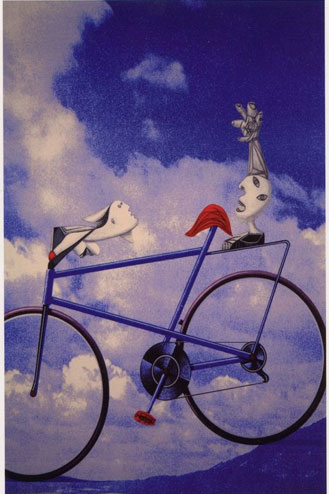He appears to be a great Catalan artist who is capable of rediscovering the mental, aesthetic and cultural bridges of Europe. In fact, the political and cultural boundaries of Europe do not coincide, and they never did. The tension between political animosity and cultural enchantment or that, say, between social catastrophe and cultural flowering, is always present.
This is reflected in the rediscovery of the mysterious unity of Europe which manifests itself in the war and hate between England and Spain of the sixteenth and seventeenth century accompanied by the unfading admiration of the poets and playwrights of Elizabethan England for Spanish literature – as we know, Lope de Vega barely survived the defeat of the Spanish Armada near the shores of England, yet he was a cultural hero in England. He could have been killed in battle, but he was admired for his immortal plays.

The admiration of William Shakespeare for Miguel de Cervantes, especially for his Don Quixote, translated into English by Thomas Shelton, which inspired Shakespeare and John Fletcher to write the comedy Cardenio (a play that is “missing” to this day) transcended the political perception of Spain as an irreconcilable and mortal foe of England.
Wasn’t this the same as what happened between nineteenth century Germany and France when the young Fichte and Hegel were filled with much anger and bitterness, resulting from the Napoleonic wars, particularly the Battle of Jena, but they could raise their champagne glasses to the French Revolution every year on 14 July, admiring French culture and the spirit of the Enlightenment? Wasn’t it the same for Russia and her former provinces or satellite states, which has always been about that same love-hate relationship, a stable pattern for Eastern and Central Europe?
Antoni Miró’s artistic language goes far beyond the predictable forms of the representation of the world we encounter each time we enter the realm of modern art. At the same time, the breadth of his historical imagination is immense. I experienced this when I had the privilege of including some of his unique artwork in the Ukrainian edition of my book Power and Imagination: Studies in Politics and Literature (translated from English into Ukrainian by Oleksandr Butsenko, artwork courtesy of Antoni Miró and Oleksandr Butsenko).

My book offered a philosophical reinterpretation of classical political and literary plots and focuses, as did Antoni Miró. Frequently described as an artist whose artistic style, ranges from figurative expressionism to pop art and realism, Miró appears to be a perceptive, albeit a somewhat ironic re-inventor and re-interpreter of several central themes and images of classical art and early modernity.
For instance, if I tried to come up with a challenging reinterpretation of Diego Velazquez’s masterpiece The Surrender of Breda, tracing it back to the conflict between the brutality and barbarity of early modern religious wars and the code of chivalry, so did Miró. This was done elegantly, in quite a daring and beautiful fashion, as if to say that nothing can be worn-out and out-of-date in our attention-seeking and self-obsessed world: We still try to emulate the greatest characters and heroes of early modernity without being conscious of it.
We still crave modern heroes, such as Don Juan (as Zygmunt Bauman, who sees Don Juan as an early hero of modernity and also as the anticipation of the consciousness of never-ending change and novelty, would have it), Don Quixote, or Ambrogio Spinola, descended from Genoese aristocracy, who became a General in the Spanish Army, and who disregards the key to the gate of the town of Breda in the hands of the surrendering Dutch General Justin von Nassau – as if to say that whereas military victory is ephemeral, the long gaze and the miracle of understanding that occurs between warring individuals endures.
We try to reconcile our moral and political sensibilities with those of the past without being able to admit that ours could be far less modern than those we tend to ascribe to the supposedly backward past. We seek our heroes among friends or mentors, predecessors or successors, ancients or moderns. We need them. The Significant Other is what comes to us as the anticipation of our own change over time or of some neglected and forgotten aspects of our biography, personal or family story.

Antoni Miró’s friend Antonio Gades, a celebrated and legendary dancer, choreographer, and political activist, appears to have become his Significant Other. Therefore, the Gades project covers an immensely rich aesthetic and mental territory of loyalty, fidelity and friendship conferred to the deceased friend of the artist – the friend who combined non-conformism, nay-say, political passion, and great artistic talent.
Last but not least, the project launched by Miró seems to have become a European one. It was through the efforts of Antoni Miró and my friend Oleksandr Butsenko, a noted Ukrainian cultural expert, translator and poet that the Gades project was brought to Ukraine and Lithuania; a project that enables us to celebrate the art of Antoni Miró, the life and the spirit of Antonio Gades, and the modern moral and aesthetic sensibilities of Europe.

